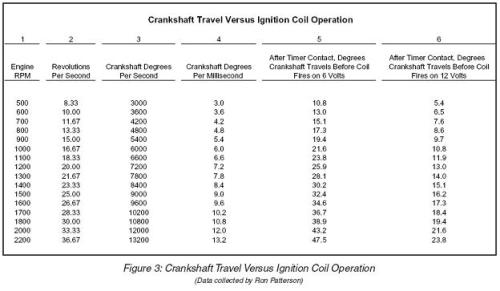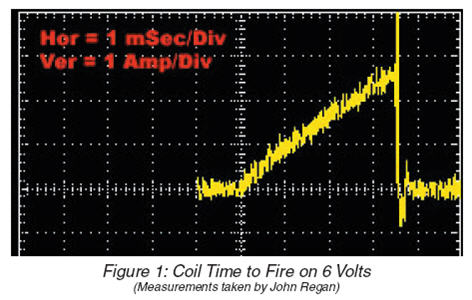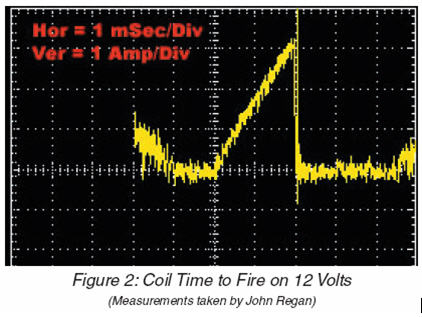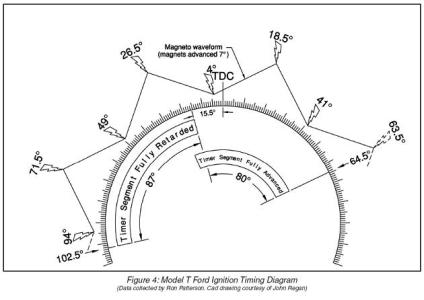|
More Ignition Timing
The following is a reproduction of another ignition timing article written by Ron Patterson
I often wondered why the Model T engine changes speed when moving the key switch back and forth from battery to magneto position and why the poor high speed engine performance when operating on 6 volts. In an effort to understand what exactly is happening, I started by taking measurements on my own Model T using an oscilloscope. I used the scope to determine the exact RPM of the motor running on battery by measuring the magneto frequency and looking for a change in RPM when switched to magneto. I took readings starting at 500 RPM in 100 RPM steps up to 1000 RPM. For each RPM step, I noted the engine speed change with the spark lever fully retarded, at midpoint and fully advanced. For the most part, the speed changes were very slight and almost imperceptible, but at 900 RPM, when switching from battery to magneto, the engine speed increased 100 RPM. After thinking about this, I realized the crankshaft travels at a different rate of speed at different RPMs, whilst the coil operating time remains constant. I calculated that at 500 RPM
the crankshaft is moving at three degrees per millisecond, and at 2200 RPM the crankshaft is moving at a rate of more than 13 degrees per millisecond. When running on magneto, if the timer is in contact, coil operation is directly tied to the current pulses that occur every 22.5 degrees of crankshaft rotation and
the coil ramp-up time varies with RPM since the magneto voltage varies with RPM. The coil ramp-up time is inversely proportional to voltage applied to the coil. Thus, at idle the
coil ramp up time when running on magneto is very long compared to a much shorter ramp-up time when running at higher RPM.
But, what is the actual speed of ignition coil operation or
“time to fire” when operating on battery? John Regan agreed to precisely measure a properly adjusted ignition coil to see how long it took to provide spark to the plug on 6 and 12 volts
after the timer segment is grounded. Those measurements are shown in Figures 1 and 2.
The horizontal time scale in Figures 1 and 2 is one millisecond per division and the vertical current scale is 1 ampere per division. The center of the scales is the instant the timer segment is grounded; one can see the current rise over a
period of time and fall when the coil fires. The peak current readings shown in Figures 1 and 2 should not be confused with average current reading obtained when using a hand-cranked
coil tester. On this particular coil the “time to fire” is 3.6 milliseconds on 6 volts and 1.8 milliseconds on 12 volts. Several correctly adjusted coils were checked with similar results. I then calculated crankshaft speed and coil operate time with respect to each other over a range of 500 to 2200 RPM as shown in Figure 3.

If one looks at Figure 3, Column 5 entitled, “After Timer Contact, Degrees Crankshaft Travels Before Coil Fires on 6
Volts” one will see at 500 RPM the piston traveled almost 11 crankshaft degrees after the timer segment is grounded and
before spark occurs. At 2200 RPM the crankshaft traveled almost 48 degrees after the timer segment is grounded and spark occurs.
Let’s make some assumptions and look at a most likely Model T scenario. The initial timing advance is set at 15.5 degrees ATDC (after top dead center) per Ford recommendations. The
engine is running at 900 RPM on battery and the spark lever is pulled down half-way on the quadrant or approximately 40 crankshaft degrees of spark advance.
Taking data from Figure 3 and looking at Figure 4, one can calculate that spark will occur at 5.1 degrees BTDC (before top dead center) running on 6 volt battery and change to 18.5 degrees BTDC when switched to magneto operation. (i.e.,40 degrees spark lever advance less initial advance of 15.5 degrees equals 24.5 degrees BTDC when timer contact is grounded, less 19.4 degrees of coil delay and the coil actually fires at 5.1 degrees BTDC. On magneto, the coil will fire at 18.5 degrees BTDC.) In this case, when switching from battery to magneto, one would expect to see an increase in engine speed because of the additional spark advance. As previously mentioned, when I measured this same scenario on my Model T, the engine speed increased 100 RPM. This is just one example and obviously there are many permutations, in some cases resulting in an increase and others a decrease in engine speed. But, why do some Model T's react differently? The answer is, there are several variable factors such as initial timing advance setting, different spark lever settings, ignition coil adjustment, throttle lever setting and the charge level of the battery. So, the answer to the first question in paragraph one: “why the Model T engine changes speed when moving the key switch back and forth from battery to magneto position?” Because spark timing with respect to piston travel changes and may be more optimal on battery than magneto or vice versa. Different Model Ts may not react in the same manner, but when the engine speed changes when switching back and forth from battery to magneto, one will be able to understand why it is occurring. From the data in Figure 3, Column 5, notice as engine speed is increased when running on battery the spark is increasingly retarded because the crankshaft is moving a greater number of degrees until the spark actually occurs. Obviously, advancing the spark lever will make up for some of this delay, but one will ultimately get to a point where the engine speed and spark delay are such that regardless of spark lever setting, the spark is not sufficiently advanced for the engine to run properly at higher speeds. The answer to the second question in paragraph one: “why the poor high speed engine performance when operating on 6 volts?” From the instant the timer roller makes contact with the case segment until the coil actually fires the plug there is a fixed delay. The crankshaft continues to move a variable distance depending upon engine speed. At higher engine speeds the crankshaft has moved to a point where the occurring spark is severely retarded, the engine simply won’t run any faster and lacks power. From the data in Figure 3 Column 6 entitled “After timer contact, degrees crankshaft travels before coil fires the spark plug using 12 volts,” notice the significantly reduced number
of degrees the crankshaft travels before the coil fires at any given engine speed. This is because the coil “time to fire” is less on 12 volts and the spark will be much further advanced when the engine is running at higher speeds, (i.e., with
the spark lever fully advanced at 1800 RPM the coil will fire at 25.6 degrees BTDC on 6 volts and 46.1 degrees BTDC on 12 volts). This explains why some people who own Model T's
with defective magnetos use 12 volt batteries to obtain better engine performance.
Get this articleIf you'd like a pdf copy of the original of this article, click below
Return to Model T Central Technical page
|



